Consumer Behaviour Report: External Influences on Purchase Decisions
VerifiedAdded on 2020/04/21
|7
|1445
|53
Report
AI Summary
This report analyzes the consumer behavior surrounding the purchase of a Swan Retro mini fridge from Tesco, priced at $100. It examines the external influences, specifically family, culture, and social class, that shaped the consumer's decision. The report details the roles played by family members in the purchasing process, highlighting how the consumer's cultural background and social standing influenced their buying behavior. The consumer, living in the US, was influenced by the individualistic culture, the product's features, and their social class, which allowed them to afford the product. The conclusion emphasizes the significance of these external factors, particularly family influence, in the consumer's final decision. The report utilizes qualitative research methods, including an interview with the consumer, to gather insights into their motivations and preferences.
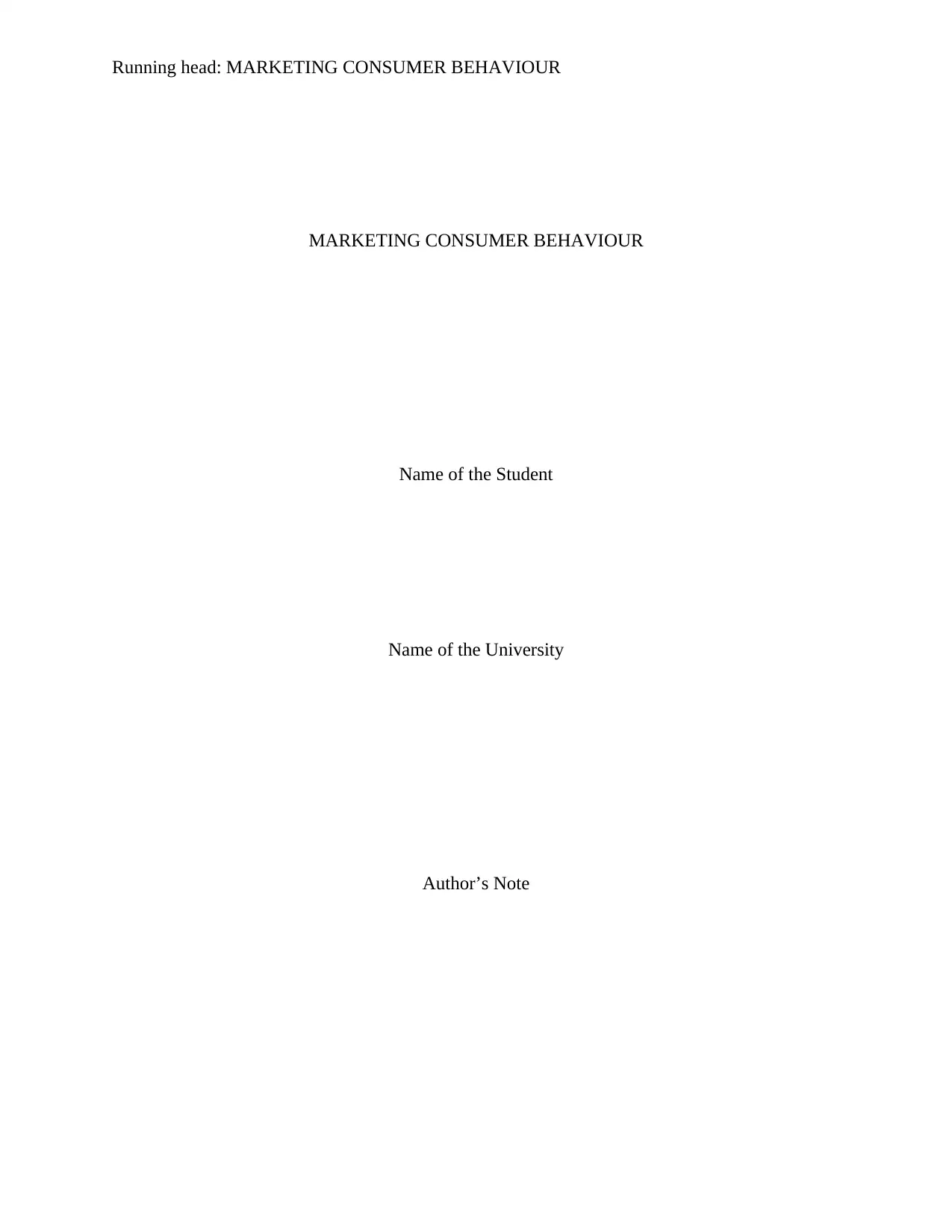
Running head: MARKETING CONSUMER BEHAVIOUR
MARKETING CONSUMER BEHAVIOUR
Name of the Student
Name of the University
Author’s Note
MARKETING CONSUMER BEHAVIOUR
Name of the Student
Name of the University
Author’s Note
Paraphrase This Document
Need a fresh take? Get an instant paraphrase of this document with our AI Paraphraser
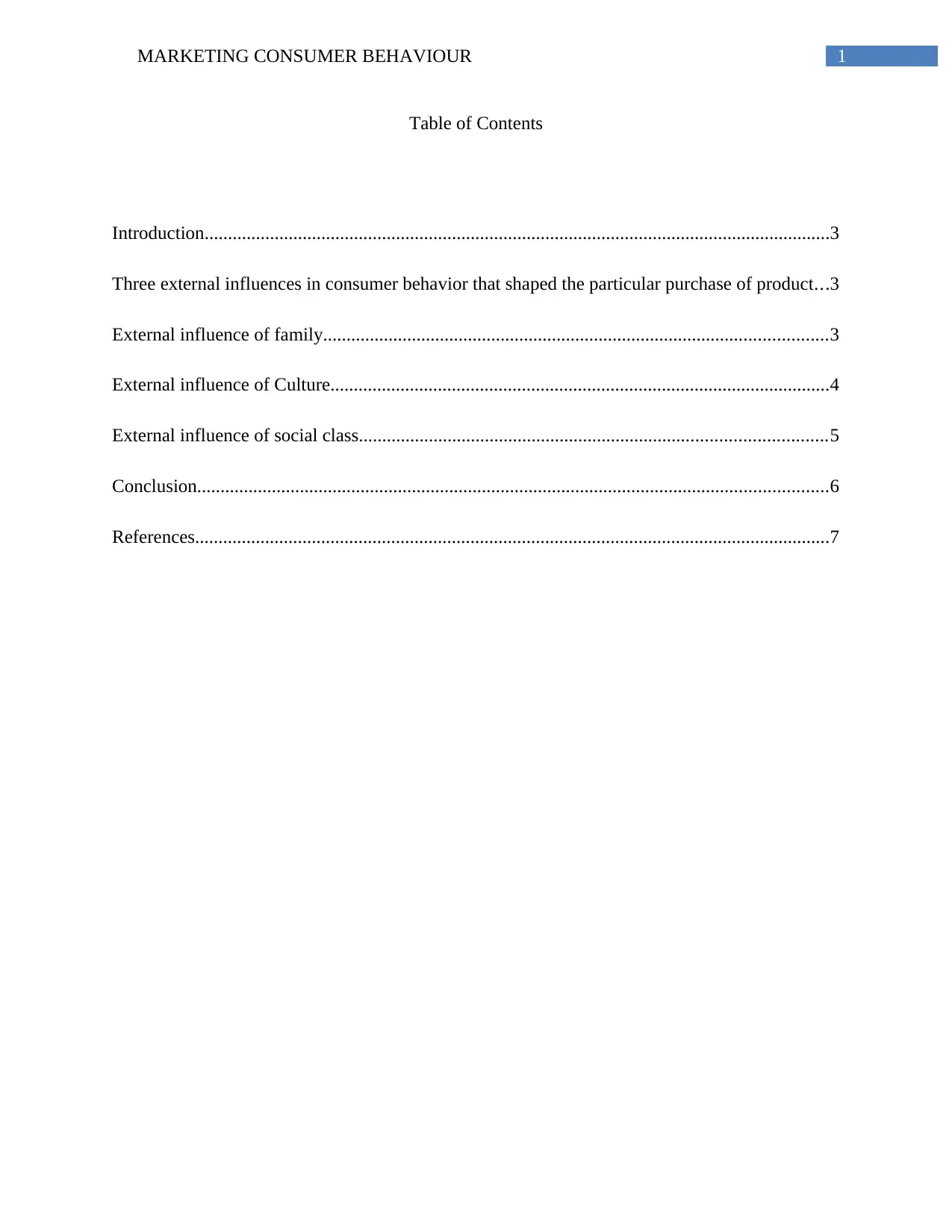
1MARKETING CONSUMER BEHAVIOUR
Table of Contents
Introduction......................................................................................................................................3
Three external influences in consumer behavior that shaped the particular purchase of product...3
External influence of family............................................................................................................3
External influence of Culture...........................................................................................................4
External influence of social class....................................................................................................5
Conclusion.......................................................................................................................................6
References........................................................................................................................................7
Table of Contents
Introduction......................................................................................................................................3
Three external influences in consumer behavior that shaped the particular purchase of product...3
External influence of family............................................................................................................3
External influence of Culture...........................................................................................................4
External influence of social class....................................................................................................5
Conclusion.......................................................................................................................................6
References........................................................................................................................................7
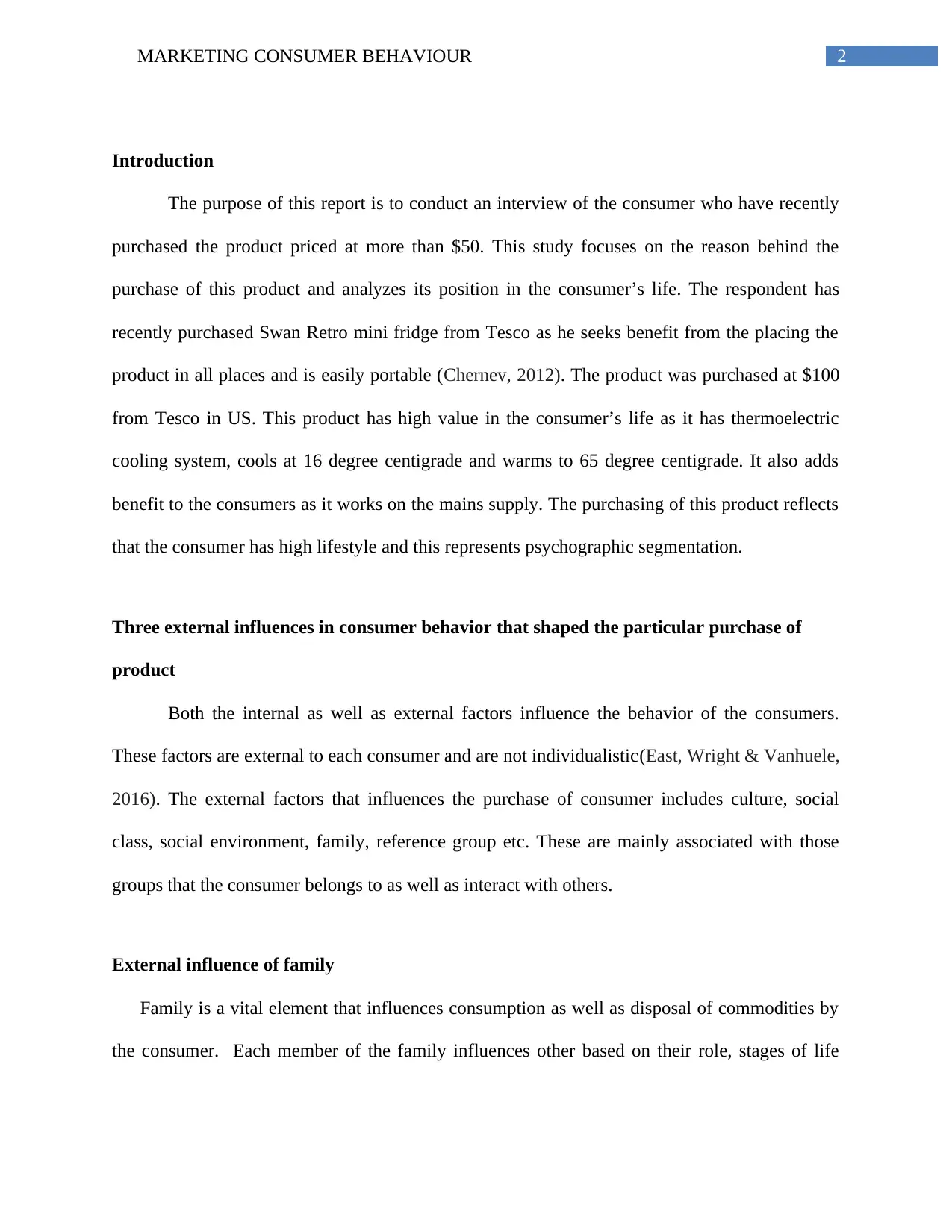
2MARKETING CONSUMER BEHAVIOUR
Introduction
The purpose of this report is to conduct an interview of the consumer who have recently
purchased the product priced at more than $50. This study focuses on the reason behind the
purchase of this product and analyzes its position in the consumer’s life. The respondent has
recently purchased Swan Retro mini fridge from Tesco as he seeks benefit from the placing the
product in all places and is easily portable (Chernev, 2012). The product was purchased at $100
from Tesco in US. This product has high value in the consumer’s life as it has thermoelectric
cooling system, cools at 16 degree centigrade and warms to 65 degree centigrade. It also adds
benefit to the consumers as it works on the mains supply. The purchasing of this product reflects
that the consumer has high lifestyle and this represents psychographic segmentation.
Three external influences in consumer behavior that shaped the particular purchase of
product
Both the internal as well as external factors influence the behavior of the consumers.
These factors are external to each consumer and are not individualistic(East, Wright & Vanhuele,
2016). The external factors that influences the purchase of consumer includes culture, social
class, social environment, family, reference group etc. These are mainly associated with those
groups that the consumer belongs to as well as interact with others.
External influence of family
Family is a vital element that influences consumption as well as disposal of commodities by
the consumer. Each member of the family influences other based on their role, stages of life
Introduction
The purpose of this report is to conduct an interview of the consumer who have recently
purchased the product priced at more than $50. This study focuses on the reason behind the
purchase of this product and analyzes its position in the consumer’s life. The respondent has
recently purchased Swan Retro mini fridge from Tesco as he seeks benefit from the placing the
product in all places and is easily portable (Chernev, 2012). The product was purchased at $100
from Tesco in US. This product has high value in the consumer’s life as it has thermoelectric
cooling system, cools at 16 degree centigrade and warms to 65 degree centigrade. It also adds
benefit to the consumers as it works on the mains supply. The purchasing of this product reflects
that the consumer has high lifestyle and this represents psychographic segmentation.
Three external influences in consumer behavior that shaped the particular purchase of
product
Both the internal as well as external factors influence the behavior of the consumers.
These factors are external to each consumer and are not individualistic(East, Wright & Vanhuele,
2016). The external factors that influences the purchase of consumer includes culture, social
class, social environment, family, reference group etc. These are mainly associated with those
groups that the consumer belongs to as well as interact with others.
External influence of family
Family is a vital element that influences consumption as well as disposal of commodities by
the consumer. Each member of the family influences other based on their role, stages of life
⊘ This is a preview!⊘
Do you want full access?
Subscribe today to unlock all pages.

Trusted by 1+ million students worldwide
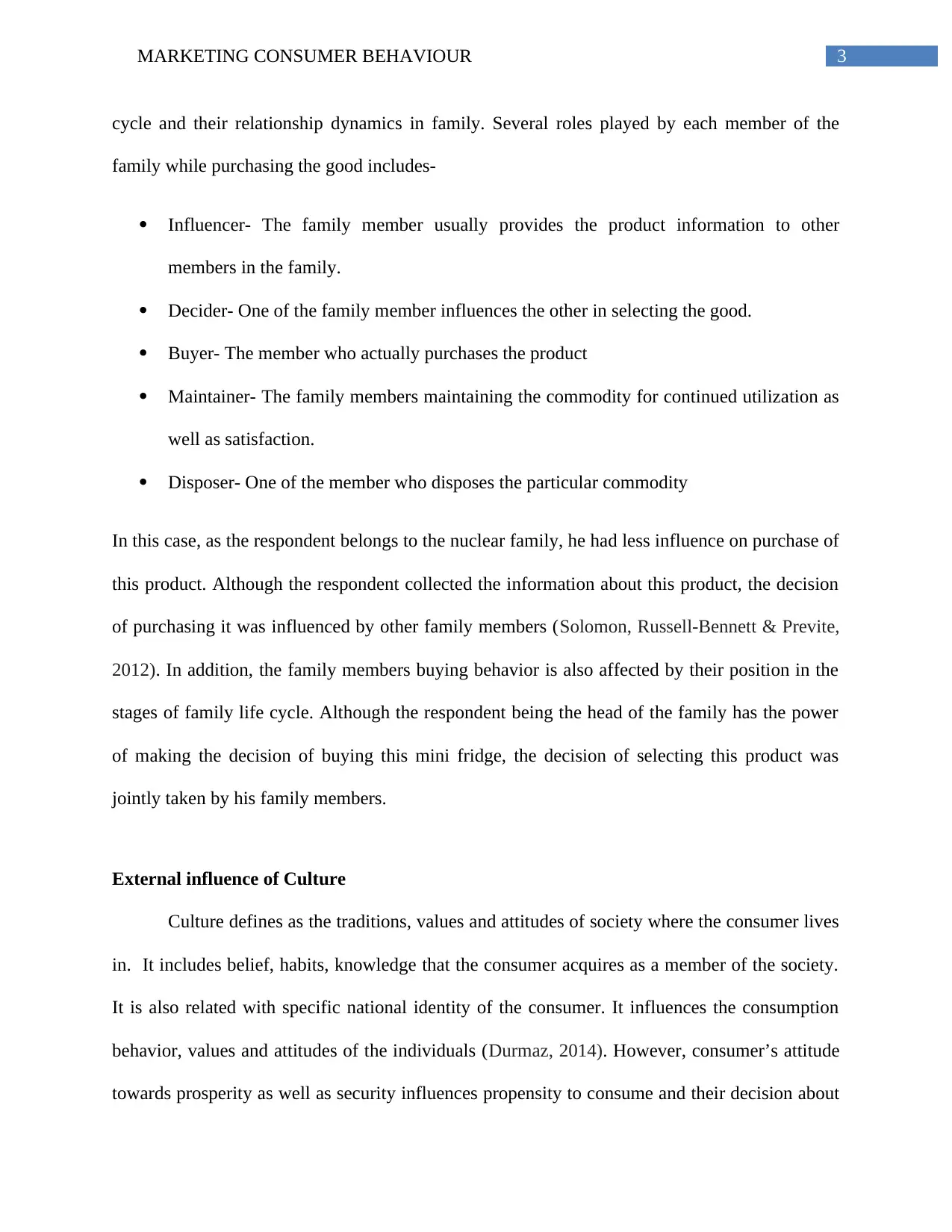
3MARKETING CONSUMER BEHAVIOUR
cycle and their relationship dynamics in family. Several roles played by each member of the
family while purchasing the good includes-
Influencer- The family member usually provides the product information to other
members in the family.
Decider- One of the family member influences the other in selecting the good.
Buyer- The member who actually purchases the product
Maintainer- The family members maintaining the commodity for continued utilization as
well as satisfaction.
Disposer- One of the member who disposes the particular commodity
In this case, as the respondent belongs to the nuclear family, he had less influence on purchase of
this product. Although the respondent collected the information about this product, the decision
of purchasing it was influenced by other family members (Solomon, Russell-Bennett & Previte,
2012). In addition, the family members buying behavior is also affected by their position in the
stages of family life cycle. Although the respondent being the head of the family has the power
of making the decision of buying this mini fridge, the decision of selecting this product was
jointly taken by his family members.
External influence of Culture
Culture defines as the traditions, values and attitudes of society where the consumer lives
in. It includes belief, habits, knowledge that the consumer acquires as a member of the society.
It is also related with specific national identity of the consumer. It influences the consumption
behavior, values and attitudes of the individuals (Durmaz, 2014). However, consumer’s attitude
towards prosperity as well as security influences propensity to consume and their decision about
cycle and their relationship dynamics in family. Several roles played by each member of the
family while purchasing the good includes-
Influencer- The family member usually provides the product information to other
members in the family.
Decider- One of the family member influences the other in selecting the good.
Buyer- The member who actually purchases the product
Maintainer- The family members maintaining the commodity for continued utilization as
well as satisfaction.
Disposer- One of the member who disposes the particular commodity
In this case, as the respondent belongs to the nuclear family, he had less influence on purchase of
this product. Although the respondent collected the information about this product, the decision
of purchasing it was influenced by other family members (Solomon, Russell-Bennett & Previte,
2012). In addition, the family members buying behavior is also affected by their position in the
stages of family life cycle. Although the respondent being the head of the family has the power
of making the decision of buying this mini fridge, the decision of selecting this product was
jointly taken by his family members.
External influence of Culture
Culture defines as the traditions, values and attitudes of society where the consumer lives
in. It includes belief, habits, knowledge that the consumer acquires as a member of the society.
It is also related with specific national identity of the consumer. It influences the consumption
behavior, values and attitudes of the individuals (Durmaz, 2014). However, consumer’s attitude
towards prosperity as well as security influences propensity to consume and their decision about
Paraphrase This Document
Need a fresh take? Get an instant paraphrase of this document with our AI Paraphraser
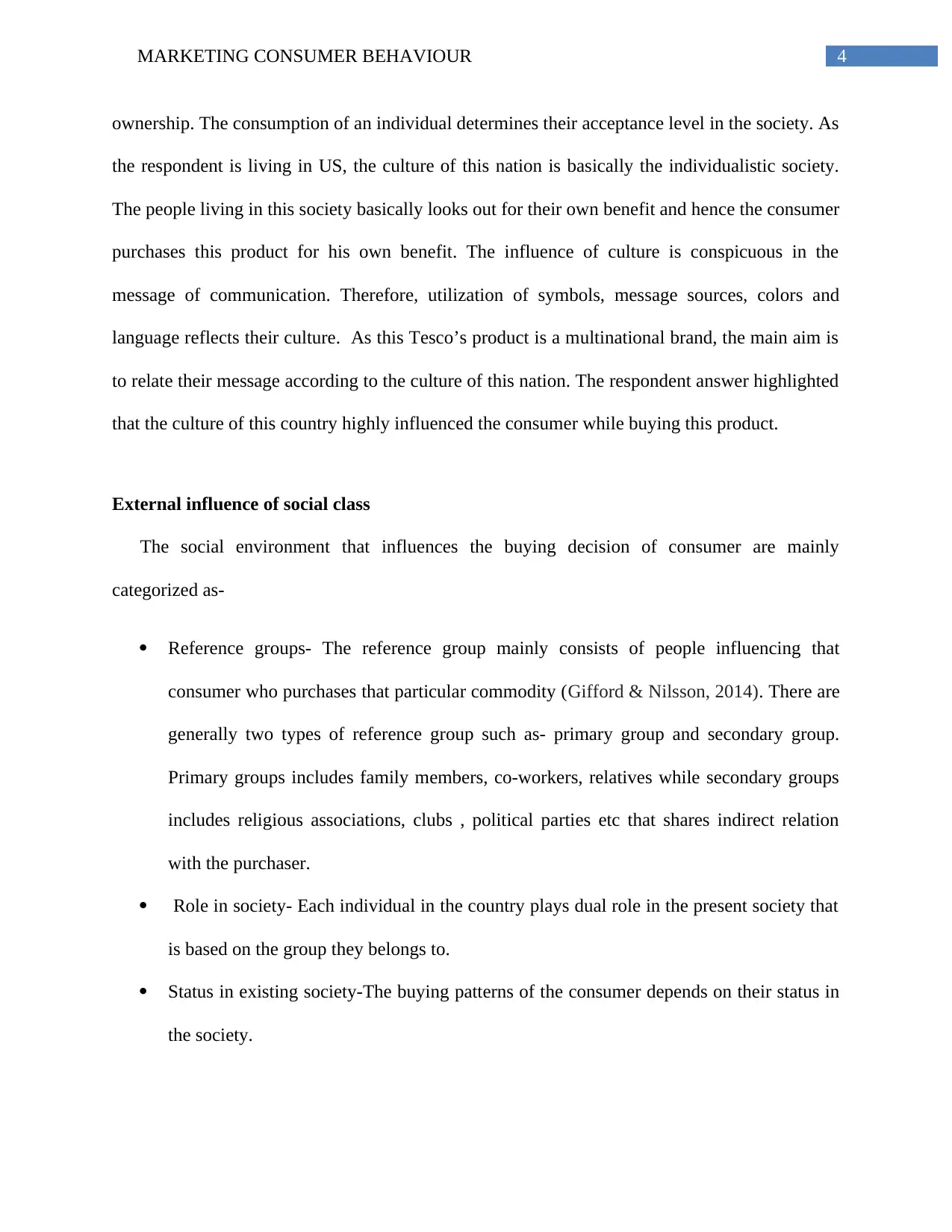
4MARKETING CONSUMER BEHAVIOUR
ownership. The consumption of an individual determines their acceptance level in the society. As
the respondent is living in US, the culture of this nation is basically the individualistic society.
The people living in this society basically looks out for their own benefit and hence the consumer
purchases this product for his own benefit. The influence of culture is conspicuous in the
message of communication. Therefore, utilization of symbols, message sources, colors and
language reflects their culture. As this Tesco’s product is a multinational brand, the main aim is
to relate their message according to the culture of this nation. The respondent answer highlighted
that the culture of this country highly influenced the consumer while buying this product.
External influence of social class
The social environment that influences the buying decision of consumer are mainly
categorized as-
Reference groups- The reference group mainly consists of people influencing that
consumer who purchases that particular commodity (Gifford & Nilsson, 2014). There are
generally two types of reference group such as- primary group and secondary group.
Primary groups includes family members, co-workers, relatives while secondary groups
includes religious associations, clubs , political parties etc that shares indirect relation
with the purchaser.
Role in society- Each individual in the country plays dual role in the present society that
is based on the group they belongs to.
Status in existing society-The buying patterns of the consumer depends on their status in
the society.
ownership. The consumption of an individual determines their acceptance level in the society. As
the respondent is living in US, the culture of this nation is basically the individualistic society.
The people living in this society basically looks out for their own benefit and hence the consumer
purchases this product for his own benefit. The influence of culture is conspicuous in the
message of communication. Therefore, utilization of symbols, message sources, colors and
language reflects their culture. As this Tesco’s product is a multinational brand, the main aim is
to relate their message according to the culture of this nation. The respondent answer highlighted
that the culture of this country highly influenced the consumer while buying this product.
External influence of social class
The social environment that influences the buying decision of consumer are mainly
categorized as-
Reference groups- The reference group mainly consists of people influencing that
consumer who purchases that particular commodity (Gifford & Nilsson, 2014). There are
generally two types of reference group such as- primary group and secondary group.
Primary groups includes family members, co-workers, relatives while secondary groups
includes religious associations, clubs , political parties etc that shares indirect relation
with the purchaser.
Role in society- Each individual in the country plays dual role in the present society that
is based on the group they belongs to.
Status in existing society-The buying patterns of the consumer depends on their status in
the society.
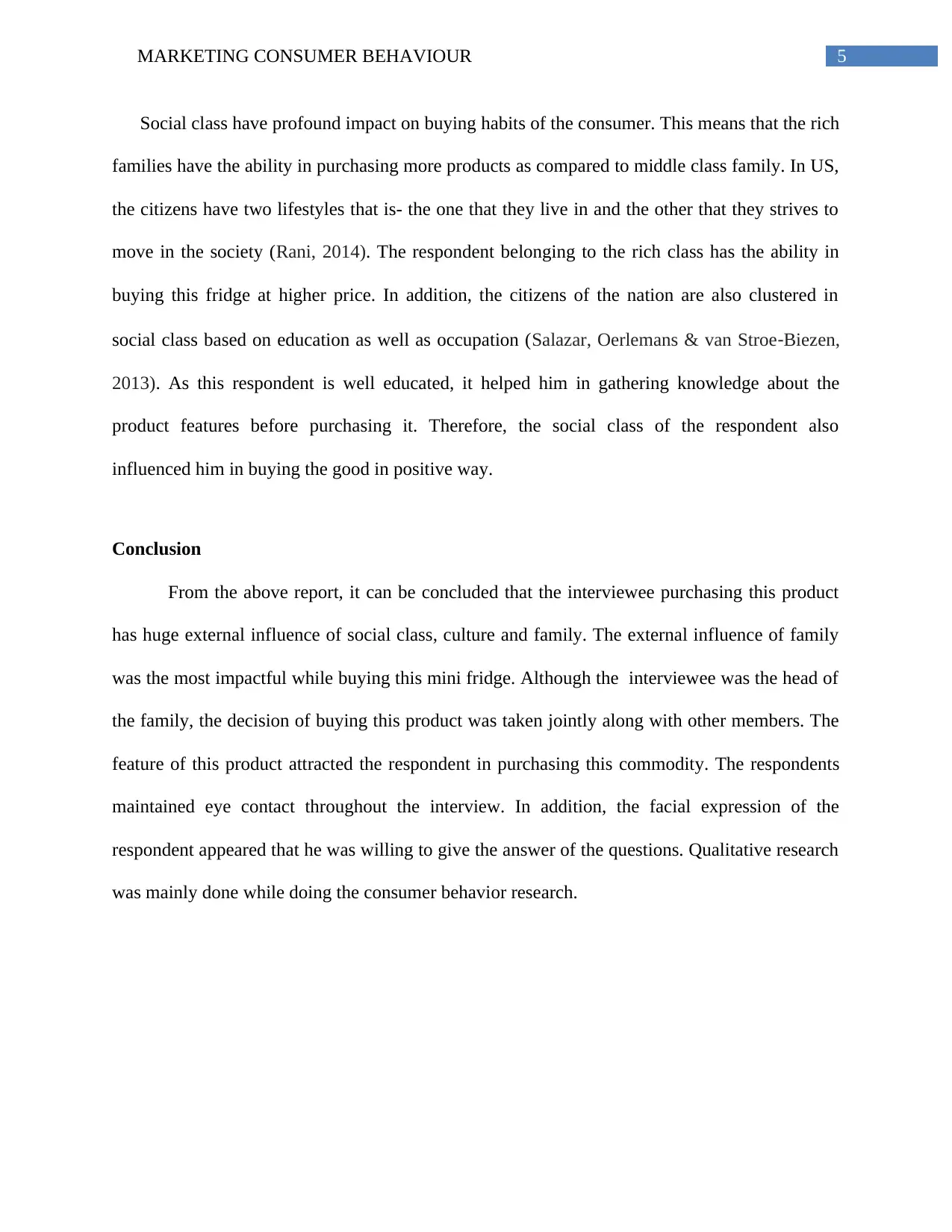
5MARKETING CONSUMER BEHAVIOUR
Social class have profound impact on buying habits of the consumer. This means that the rich
families have the ability in purchasing more products as compared to middle class family. In US,
the citizens have two lifestyles that is- the one that they live in and the other that they strives to
move in the society (Rani, 2014). The respondent belonging to the rich class has the ability in
buying this fridge at higher price. In addition, the citizens of the nation are also clustered in
social class based on education as well as occupation (Salazar, Oerlemans & van Stroe‐Biezen,
2013). As this respondent is well educated, it helped him in gathering knowledge about the
product features before purchasing it. Therefore, the social class of the respondent also
influenced him in buying the good in positive way.
Conclusion
From the above report, it can be concluded that the interviewee purchasing this product
has huge external influence of social class, culture and family. The external influence of family
was the most impactful while buying this mini fridge. Although the interviewee was the head of
the family, the decision of buying this product was taken jointly along with other members. The
feature of this product attracted the respondent in purchasing this commodity. The respondents
maintained eye contact throughout the interview. In addition, the facial expression of the
respondent appeared that he was willing to give the answer of the questions. Qualitative research
was mainly done while doing the consumer behavior research.
Social class have profound impact on buying habits of the consumer. This means that the rich
families have the ability in purchasing more products as compared to middle class family. In US,
the citizens have two lifestyles that is- the one that they live in and the other that they strives to
move in the society (Rani, 2014). The respondent belonging to the rich class has the ability in
buying this fridge at higher price. In addition, the citizens of the nation are also clustered in
social class based on education as well as occupation (Salazar, Oerlemans & van Stroe‐Biezen,
2013). As this respondent is well educated, it helped him in gathering knowledge about the
product features before purchasing it. Therefore, the social class of the respondent also
influenced him in buying the good in positive way.
Conclusion
From the above report, it can be concluded that the interviewee purchasing this product
has huge external influence of social class, culture and family. The external influence of family
was the most impactful while buying this mini fridge. Although the interviewee was the head of
the family, the decision of buying this product was taken jointly along with other members. The
feature of this product attracted the respondent in purchasing this commodity. The respondents
maintained eye contact throughout the interview. In addition, the facial expression of the
respondent appeared that he was willing to give the answer of the questions. Qualitative research
was mainly done while doing the consumer behavior research.
⊘ This is a preview!⊘
Do you want full access?
Subscribe today to unlock all pages.

Trusted by 1+ million students worldwide
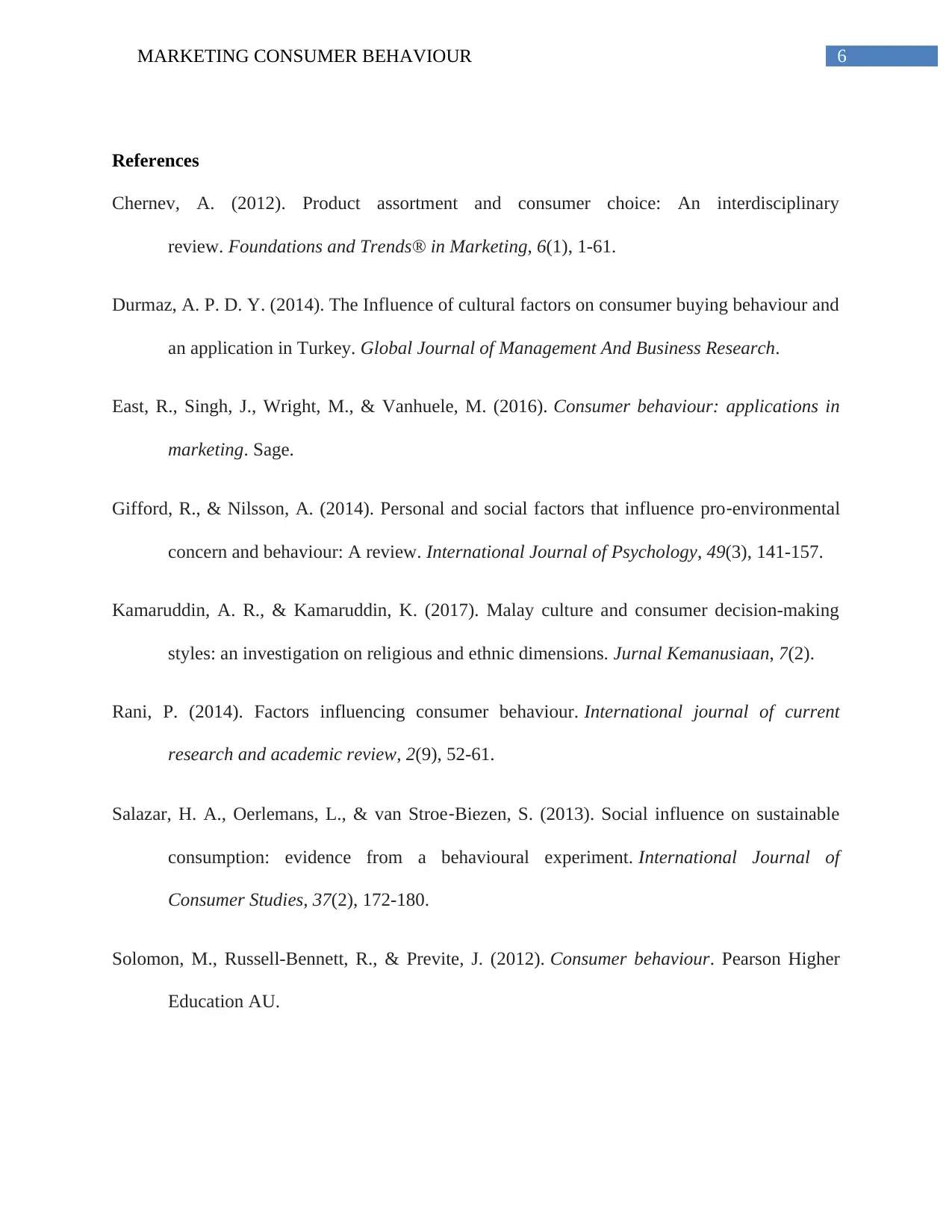
6MARKETING CONSUMER BEHAVIOUR
References
Chernev, A. (2012). Product assortment and consumer choice: An interdisciplinary
review. Foundations and Trends® in Marketing, 6(1), 1-61.
Durmaz, A. P. D. Y. (2014). The Influence of cultural factors on consumer buying behaviour and
an application in Turkey. Global Journal of Management And Business Research.
East, R., Singh, J., Wright, M., & Vanhuele, M. (2016). Consumer behaviour: applications in
marketing. Sage.
Gifford, R., & Nilsson, A. (2014). Personal and social factors that influence pro‐environmental
concern and behaviour: A review. International Journal of Psychology, 49(3), 141-157.
Kamaruddin, A. R., & Kamaruddin, K. (2017). Malay culture and consumer decision-making
styles: an investigation on religious and ethnic dimensions. Jurnal Kemanusiaan, 7(2).
Rani, P. (2014). Factors influencing consumer behaviour. International journal of current
research and academic review, 2(9), 52-61.
Salazar, H. A., Oerlemans, L., & van Stroe‐Biezen, S. (2013). Social influence on sustainable
consumption: evidence from a behavioural experiment. International Journal of
Consumer Studies, 37(2), 172-180.
Solomon, M., Russell-Bennett, R., & Previte, J. (2012). Consumer behaviour. Pearson Higher
Education AU.
References
Chernev, A. (2012). Product assortment and consumer choice: An interdisciplinary
review. Foundations and Trends® in Marketing, 6(1), 1-61.
Durmaz, A. P. D. Y. (2014). The Influence of cultural factors on consumer buying behaviour and
an application in Turkey. Global Journal of Management And Business Research.
East, R., Singh, J., Wright, M., & Vanhuele, M. (2016). Consumer behaviour: applications in
marketing. Sage.
Gifford, R., & Nilsson, A. (2014). Personal and social factors that influence pro‐environmental
concern and behaviour: A review. International Journal of Psychology, 49(3), 141-157.
Kamaruddin, A. R., & Kamaruddin, K. (2017). Malay culture and consumer decision-making
styles: an investigation on religious and ethnic dimensions. Jurnal Kemanusiaan, 7(2).
Rani, P. (2014). Factors influencing consumer behaviour. International journal of current
research and academic review, 2(9), 52-61.
Salazar, H. A., Oerlemans, L., & van Stroe‐Biezen, S. (2013). Social influence on sustainable
consumption: evidence from a behavioural experiment. International Journal of
Consumer Studies, 37(2), 172-180.
Solomon, M., Russell-Bennett, R., & Previte, J. (2012). Consumer behaviour. Pearson Higher
Education AU.
1 out of 7
Related Documents
Your All-in-One AI-Powered Toolkit for Academic Success.
+13062052269
info@desklib.com
Available 24*7 on WhatsApp / Email
![[object Object]](/_next/static/media/star-bottom.7253800d.svg)
Unlock your academic potential
Copyright © 2020–2025 A2Z Services. All Rights Reserved. Developed and managed by ZUCOL.





